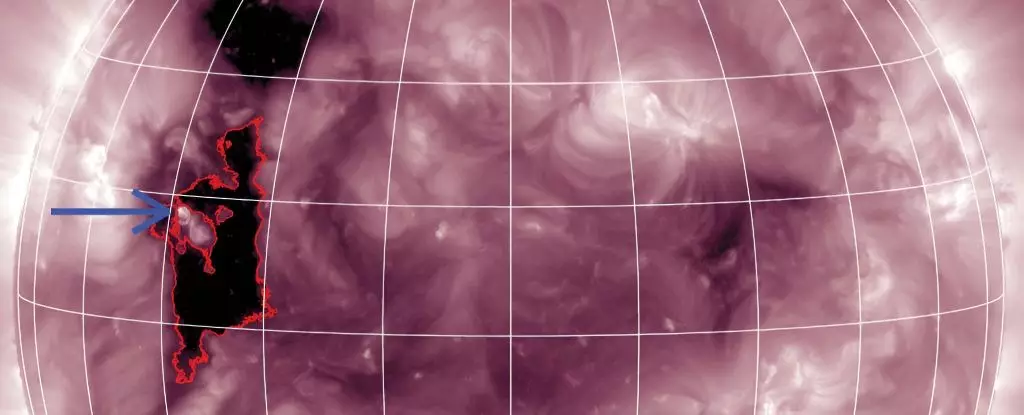In a remarkable turn of events, astrophysicists have recently observed an unprecedented emission of helium-3 from the Sun, igniting excitement in the astronomical community. This rare isotope, one of the lightest helium forms, was launched from a coronal hole in late October 2023, resulting in an outpouring that far surpasses previous measurements. Academics and enthusiasts alike are pondering the implications of this phenomenon not just for solar science, but for our understanding of the cosmos at large.
Astrophysicist Radoslav Bučík of the Southwest Research Institute articulates the significance of this finding, noting that helium-3 exists at an astonishingly rare ratio: roughly one helium-3 ion for every 2,500 helium-4 ions present in the solar wind. The recent eruption, however, saw helium-3 levels skyrocketing, suggesting that solar jets possess a unique ability to accelerate this isotope to extraordinary rates, largely due to its distinctive charge-to-mass ratio. Why is this significant? It poses questions about the mechanics of solar activity and the composition of stellar emissions, challenging existing paradigms.
The Significance of Coronal Holes
Coronal holes have steadily become a focus in solar research due to their unique characteristics. Unlike the denser, more magnetic regions of the Sun’s atmosphere, these patches provide a glimpse into a less turbulent world, where solar winds can escape unimpeded. Observations captured by NASA and ESA’s Solar Orbiter unveiled a fascinating landscape where magnetic fields are notably weaker. Such conditions seemingly favor the release of lighter particles, paving the way for the helium-3 surge.
On the 24th and 25th of October 2023, these observations reached new heights, revealing helium-3 concentrations that were 180,000 times the standard levels found in the solar atmosphere. This discovery captures both the imagination and the minds of scientists dedicated to unraveling the complex behaviors of the Sun’s atmosphere. These findings support early hypotheses suggesting that helium-3 enrichment may be more pronounced in areas of weaker magnetism, creating a paradoxical yet tantalizing scenario—could the quiet areas of the Sun be where cosmic treasures are formed?
The Chemistry of Solar Jets
The October event presented an array of surprises, particularly in its chemical composition. While solar particle events generally boast heavy element influxes—spanning iron, neon, and beyond—this instance starkly deviated from the norm. Notably, the absence of increased iron levels in tandem with substantial enhancements in carbon, nitrogen, silicon, and sulfur raises intriguing questions about the nuclear processes occurring within these solar jets.
Examining only 19 other solar particle events recorded between 1999 and 2023 showed similarly distinctive chemistry, suggesting the potential for a broader class of such outbursts. Are these events truly uncommon, or are they often overlooked due to their typically lower energy profiles that escape detection from our distant vantage point? Solar Orbiter’s positioning, approximately halfway to the Sun from Earth, offers a unique vantage for capturing these intricate behaviors in unparalleled detail.
The Broader Implications for Solar Physics
The study of helium-3 is more than an esoteric pursuit; it holds practical implications for future solar research and potentially revolutionizes the understanding of solar dynamics. Helium-3 is not only a resource of interest for researchers, but also a potential fuel for nuclear fusion, emphasizing its relevance to energy discussions on Earth. Investigating its production and behavior in the solar atmosphere could provide significant insights that transcend astrophysics and enter practical applications in energy resources.
As scientists continue delving into phenomena like the recent helium-3 surge, a picture emerges of the Sun as an entity rich in mysteries waiting to be unraveled. Each event, whether it be a powerful solar flare or a quiet coronal hole, offers unique insights into the processes and cycles that govern our stellar neighbor. For researchers, this promising discovery is just a piece of a more extensive puzzle that invites the question: what other cosmic events lie cloaked in the layers of stellar emissions, waiting for the right instruments and theories to uncover their secrets?
Exploring these collision between theories and observations brightens the horizon for solar science, suggesting that even the quiet regions of our Sun can harbor explosive secrets. As we stand on the brink of new discoveries and technologies, the universe reminds us of the endless curiosity that defines the human spirit. The unanswered questions surrounding helium-3 serve only to deepen our desire to understand the intricate tapestry of the cosmos, fundamentally shifting our relationship with the stars we seek to comprehend.

